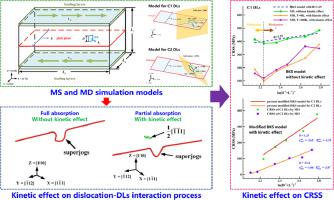International Journal of Plasticity ( IF 9.8 ) Pub Date : 2023-03-29 , DOI: 10.1016/j.ijplas.2023.103603 Qifan Bao , Zhenhuan Li , Bida Zhu , Shuang Liang , Jianchang Zhu , Minsheng Huang , Lv Zhao , Yaxin Zhu

|
In this paper, the interaction between an edge dislocation and irradiation <100> sessile self-interstitial atom (SIA) type dislocation loops (DLs) is studied by atomistic simulations in BCC Ta at 0 and 300 K. Both molecular dynamics (MD) and statics (MS) simulations are performed to highlight the dislocation kinetic effect (or dynamic effect) on the critical resolved shear stress (CRSS) for dislocation bypassing the DLs and on the dislocation-SIA DLs interaction mechanisms. The simulation results show that the dislocation-DLs interaction mechanisms are two-fold. When the DL size is lower than a critical value, the moving edge dislocation tends to completely absorb the DLs or fully transform the original DLs into other-type ones. However, when the DL size is higher than the critical value, the moving dislocation tends to absorb or transform the DLs partially or even marginally. Moreover, with increasing applied shear stress, the high-speed dislocation has no sufficient time to absorb SIAs from DLs, which also changes the dislocation-DLs interaction process remarkably. When the dislocation is accelerated to subsonic, an abnormal “pull forward” dislocation configuration may present upon the dislocation bypasses a small DL. More importantly, with the kinetic effect considered, the CRSS for dislocation overcoming the barriers of DLs decreases significantly for the dislocation-DLs interaction mechanisms. In order to appropriately describe the kinetic effect on the CRSS, amended dispersed barrier hardening (DBH) and Bacon-Kocks-Scattergood (BKS) hardening models for the latter dislocation-DLs interaction mechanism are proposed.
中文翻译:

动力学效应对 BCC 钽中刃型位错与辐照位错环相互作用的影响
在本文中,边缘位错与辐照 <100> 固着自填隙原子 (SIA) 型位错环 (DLs) 之间的相互作用通过 BCC Ta 在 0 和 300 K 的原子模拟进行了研究。分子动力学 (MD) 和执行静力学 (MS) 模拟以突出位错动力学效应(或动态效应)对绕过 DL 的位错的临界分解剪切应力 (CRSS) 和位错-SIA DL 相互作用机制的影响。模拟结果表明位错-DLs 相互作用机制有两个方面。当 DL 尺寸低于临界值时,移动边缘位错倾向于完全吸收 DL 或将原始 DL 完全转变为其他类型的 DL。然而,当 DL 大小高于临界值时,移动的位错倾向于部分或什至轻微地吸收或转化 DL。此外,随着施加的剪切应力的增加,高速位错没有足够的时间从 DLs 吸收 SIA,这也显着改变了位错-DLs 的相互作用过程。当位错加速到亚音速时,异常的“前拉”位错配置可能会出现在位错绕过小的 DL 时。更重要的是,考虑到动力学效应,位错克服 DLs 障碍的 CRSS 对于位错-DLs 相互作用机制显着降低。为了适当地描述对 CRSS 的动力学影响,针对后者的位错-DLs 相互作用机制提出了修正的分散势垒硬化 (DBH) 和 Bacon-Kocks-Scattergood (BKS) 硬化模型。



























 京公网安备 11010802027423号
京公网安备 11010802027423号